Kittredge Cherry's Blog: Q Spirit, page 51
October 3, 2013
Brother Elias: Soulmate to Saint Francis of Assisi?
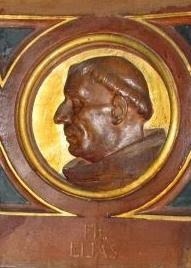
Portrait of Brother Elias at the Baptismal font where St. Francis was christened in the Cathedral of San Rufino in Assisi. (Photo by Kevin Elphick)
[Note: This article provides detailed references on the love between St. Francis of Assisi and Brother Elias of Cortona. For an overview on the queer side of Saint Francis, see "New info on Francis of Assisi’s queer side revealed."]
By Kevin Elphick
The earliest companion of Francis, a man whom Francis “loved more than any other because he was the same age” and because of “the great familiarity of their mutual affection…” is quickly written out of all but the earliest biographies and becomes fully lost and cleansed from later biographies. There is reason for suspicion about his removal from the story of Francis as the officially sanctioned image of St. Francis “the Saint” grew more widely circulated in the Medieval Church.
One possible candidate for Francis' first, unnamed companion is Brother Elias. The noted Franciscan historian, John Moorman, puts forward this supposition in his book, A History of the Franciscan Order (Chicago: Franciscan Herald Press, 1988. p. 96). In Celano's First Life of Francis, Br. Elias is not overtly named until Chapter 25, with no introduction or description, as if he is a character in the narrative already previously introduced. And yet, in spite of seemingly appearing only by Chapter 25, Elias is one of "three other historical figures [which] find an honored place within the pages" of Celano's work (St. Clare and Pope Gregory are the other two; Francis of Assisi - The Saint: Early Documents, NY: New City Press, 1999; p. 173). If the important figure of Br. Elias has already appeared in Chapter 3, it is more cohesive to the narrative when he reappears in Chapter 25 wherein the text [re]introduces him [again ?] with Francis "on another occasion and brother Elias was with him..."
The intimacy of Francis' relationship with Elias is described as "the one he [Francis] chose for the role of mother to himself." (Second Book, Chapter 4)
After Peter Catanii, Elias is one of the earliest Minister Generals of the Order. Before his death, Francis singles out Elias and intones a unique blessing over him. Upon his deathbed, Francis requests that the chapter from the Gospel of John be read to him (in which the Beloved Disciple is first introduced), and "This was the very gospel his minister [Elias] had planned to read. (Celano, Chapter 8) Celano sets up this scene by reminding readers that Elias was the one whom Francis "loved with great affection." The Latin here, "diligebat," is the same verb for love used in the Latin Vulgate for Jesus' love of the Beloved Disciple (Jn. 13:23)
At his death, Elias writes a letter to the Franciscan community, to share the distressing news of Francis' passing. Yet in this letter Elias describes it as "a loss for all, yet it is a trial singularly my own." He writes: "I sigh... My groans gush forth... what I dreaded has happened to me..." That this death is personalized for Elias is explicit. Elias remembers Francis as one who "carried us in his arms like lambs..."
Elias continues with praise of Francis' body itself. His letter betrays a clear intimacy he knew with Francis' body: "...our brother... bearing in his body... His hands and feet...front and back revealing the scars... His side...often emitted blood...No part of his body was without great suffering...His limbs… marvelously soft and pliable...turned this way and that..." Clearly Elias is writing from a personal and physical intimacy with Francis.
Interestingly, it is St. Bonaventure, the fifth successor to Elias as Minister General of the Order, who writes Elias out of Francis' official biographies. Bonaventure orders all earlier biographies of Francis to be destroyed. He then authors two "official" biographies of Francis and removes all mention of Francis' earliest, first companion. While he includes two episodes of Elias' role in Francis' life, Bonaventure does not name him, whereas other early friars are explicitly named. In describing Francis' blessing which he extended prior to his death, Bonaventure removes Elias as the recipient, and instead describes the blessing as being given generally to the friars "sitting around him." Subsequent biographies eventually adopt a trajectory openly hostile to the depiction of Elias.
However, notably, St. Clare, another intimate companion of Francis and contemporary of Francis, gives an affirmation of Elias in the strongest possible language. She writes to Blessed Agnes: "In all of this, follow the counsel of our venerable Father, our Brother Elias, the Minister General... Prize it beyond the advice of the others and cherish it as dearer to you than any gift."
___
Kevin Elphick is a Franciscan scholar and a supervisor on a suicide prevention hotline in New York. He wrote a thesis on “Gender Liminality in the Franciscan Sources” for a master’s degree in Franciscan studies from St. Bonaventure University in New York.
____
This post is part of the GLBT Saints series by Kittredge Cherry at the Jesus in Love Blog. Saints, martyrs, mystics, prophets, witnesses, heroes, holy people, humanitarians, deities and religious figures of special interest to lesbian, gay, bisexual and transgender (LGBT) and queer people and our allies are covered on appropriate dates throughout the year.
Published on October 03, 2013 09:16
October 2, 2013
Funds needed now for annual newsletter fee
 I need $363 by Oct. 19 to pay the annual fee for the Jesus in Love Newsletter on LGBT spirituality and the arts.
I need $363 by Oct. 19 to pay the annual fee for the Jesus in Love Newsletter on LGBT spirituality and the arts.Gifts of any size are welcome. Your gift of $30 pays for everybody to get the newsletter for one month.
Please give now by clicking the “GoFundMe” button below or visiting my GoFundMe page.
The Jesus in Love Newsletter now has 885 subscribers -- an increase of 85 compared to a year ago. The newsletter is successfully bringing the good news of LGBT spirituality and art to more people.
And Jesus in Love makes a big impact on each person. Listen to one of my readers: “Jesus in Love is the most radically progressive and life affirming Christian LGBT site on the Internet that I have ever seen. I find its message both inspiring and empowering,” says Ernesto Borges Torres.
See for yourself. Use the following list to view five years of past newsletters online. The annual fee includes maintenance of this newsletter archive.
 Thank you for helping me support LGBT spirituality and the arts! I am a lesbian Christian author and Jesus in Love is my gift to the world. Jesus in Love is my individual project, so your gifts to Kittredge Cherry for Jesus in Love are not tax deductible.
Thank you for helping me support LGBT spirituality and the arts! I am a lesbian Christian author and Jesus in Love is my gift to the world. Jesus in Love is my individual project, so your gifts to Kittredge Cherry for Jesus in Love are not tax deductible.  Sign up for our Email Newsletter
Sign up for our Email Newsletter JL News Sept 2013 (9/12/2013)
Gay artist Richard Stott paints "Intimacy with Christ," Saints Bernard of Clairvaux and Malachy, Proud Jesus blesses LGBT Pride parades, gay saint of 9/11 Mychal Judge, John Henry Newman and Ambrose St. John, lesbian goddess roots of Mary's Feast of the Assumption, civil rights champion Bayard Rustin, Christ and Krishna
JL News August 2013 (8/4/2013)
Black Madonna and lesbian defender Erzulie Dantor, gay Russian saints Boris and George, Wojnarowicz art and religion, LGBT resurrection by Mary Button, new translator at Santos Queer, bearded woman saint Wilgefortis
JL News July 2013 (7/6/2013)
Queer religious art list resource list: (Buddhism, Hinduism, Islam, Judaism, Paganism), UpStairs Lounge fire 40 years later, Pauli Murray (queer saint and first black woman ordained as an Episcopal priest), Saint Symeon and John (holy fool and hermit who loved each other), Jemima Wilkinson (queer preacher reborn in 1776 as “Publick Universal Friend”)
JL News June 2013 (6/5/2013)
Will Roscoe on Jesus and the shamanic tradition of same-sex love, cross-dressing painter Rosa Bonheur honors "androgyne Christ," Hidden Perspectives interviews Kittredge Cherry on LGBT religion, Adam and Steve welcome marriage equality, Joan of Arc, Rainbow Christ Prayer, Julian of Norwich
JL News May 2013 (5/2/2013)
Photos of LGBT saints today by Tony O'Connell, LGBT vs Christian cartoon by Carlos Latuff for Day Against Homophobia, LGBT Litany, Christina Rossetti, Sor Juana de la Cruz, new books
JL News Easter / April 2013 (3/31/2013)
Happy Easter, gay Passion of Christ series ends when Jesus rises and appears to Mary, marriage equality vigil, queer Buddhist Christ figure Kuan Yin, lesbian poet Adrienne Rich
JL News: Palm Sunday 2013 (3/24/2013)
Gay Passion of Christ paintings by Douglas Blanchard with text by Kittredge Cherry, LGBT Stations of the Cross by Mary Button, right-wing rants against queer Christ
JL News Mar 2013 (3/2/2013)
Artist Ria Brodell paints history's butch heroes, queer martyrs rise on Ash Wednesday, Polyeuct and Nearchus, Queen Esther, new books
JL News Feb 2013 (2/9/2013)
Top 10 LGBT spiritual arts stories of 2012, LGBT clergy at Inauguration, Saint Sebastian, Lesbian Virgin Mary poster protested in Croatia, Beloved Disciple, Holocaust Remembrance with pink triangle art, Brigid and Darlughdach, David and Jonathan, Ugandan LGBT maryr David Kato
JL News Xmas 2012 / Jan 2013 (12/24/2012)
Queer baby Jesus, gay Nativity in Columbia, artist Eric Martin paints naked young man from Mark's gospel, John of the Cross, ad shows Pope blessing same-sex marriage, Bridge of Light holiday for New Year
JL News December 2012 (12/4/2012)
Divine lesbian art by Verlena Johnson, Advent, blasphemy charges for Greek gay Jesus play, Top 20 gay Jesus books, gay King Wenceslas, mystical same-sex marriage of Bernardo de Hoyos, queer Christmas gift ideas
JL News November 2012 (11/1/2012)
More LGBTQ saints added for All Saints Day, LGBTQ guide to American Academy of Religion - Society of Biblical Studies meeting, Cardinal John Henry Newman loved Ambrose St. John, Angela Yarber paints portrait of Kittredge Cherry, gay martyrs Sergius & Bacchus, We Wha of Zuni, Jesus in Love's 7th anniversary
JL News October 2012 (10/4/2012)
Queer Saint Francis of Assisi, Henri Nouwen struggles with his homosexuality, Dr. Hildegard of Bingen loved women, Jesus in rainbow shroud, Rumi inspired by same-sex love, Leviticus and religion-based violence
JL News September 2012 (9/3/2012)
Tony De Carlo's art (gay saints, Adam and Steve, marriage equality), gay Christ by Latuff, gay civil-rights saint Bayard Rustin, Mary's lesbian goddess roots

JL News August 2012 (8/2/2012)
Queer grace with art by Felicia Follum, marriage of Jesus and Freddie Mercury by Mr. Fish, Pauli Murray voted into sainthood, blasphemy charge from Americans for Truth, queer saints Wilgefortis, Boris & George, Artemisia Gentileschi
July 2012 (7/1/2012)
Queer saint for Independence Day: Jemima Wilkinson was reborn in 1776 as “Publick Universal Friend,” Rainbow Christ Prayer by Kittredge Cherry and Patrick Cheng, cartoon shows Jesus walking on dangerous waters carrying LGBT kid, my first LGBT Pride march
Kittredge Cherry Update, July 2012 (7/25/2012)
Sample issue of KC Update, a monthly e-newsletter with timely reflections on LGBT spirituality and art. KC Update is available only to paid subscribers for $25 per month or $300 per year.
June 2012 (6/6/2012)
Stonewall paintings by Sandow Birk, Sweden's first LGBT altar by Elisbeth Ohlson Wallin, resurrection images from Gay Passion of Christ with art by Doug Blanchard and text by Kittredge Cherry, 2 new gay Jesus books, Joan of Arc, LGBT Pride prayers
May 2012 (5/3/2012)
Ethiopian eunuch shows early church welcomed queers, gay teen wins right to wear "Jesus is not a homophobe" shirt on Day of Silence, lesbian poet Christina Rossetti, gay Jesus makes news in the Guardian, Sor Juana de la Cruz loved a countess
Easter 2012 (4/8/2012)
Happy Easter with Queer Resurrection by Andrew Craig Wiliams, Gay Passion of Christ series by Douglas Blanchard ends, Queer Christ article in Huffington Post by Kittredge Cherry -- and conservative attacks on it
April 2012 (4/1/2012)
Gay Passion of Christ series with art by Douglas Blanchard and new text by Kittredge Cherry, gay Jesus kiss behind the scenes at "Corpus Christi," Queens Esther and Vashti, gay centurion, new queer Christ book by Patrick Cheng
March 2012 (3/1/2012)
Angela Yarber paints holy lesbian icons and other women, "Most Fabulous Story Ever Told" protested, executions for sodomy, closeted Jesus in "Dark Knowledge," Polyeuct and Nearchus, St. Valentine: marriage-equality role model
February 2012 (2/3/2012)
Top 10 LGBT spiritual arts stories of 2011, police investigate attack on gay / lesbian Nativity scene at California church, Ugandan LGBT rights activist David Kato remembered one year later, St. Brigid and her female soulmate, Kittredge Cherry starts writing for Huffington Post
Christmas 2011 / New Years 2012 (12/24/2011)
Christmas greetings, LGBT Nativity contest, queer saints on Huffington Post, Clinton tells UN that gay rights are human rights, Bridge of Light LGBT New Year ceremony
December 2011 (12/7/2011)
History's gay couples by artist Ryan Grant Long, mystical same-sex marriage of Blessed Bernardo de Hoyos and Jesus, LGBT Nativity contest, LGBTQ guide to American Academy of Religion
November 2011 (11/1/2011)
All Saints Day reflection on why we need LGBT saints, new LGBT spirituality resource pages, All Saints / All Souls memorial, author Hartman on gay Jesus, We'wha of Zuni (two-spirit Native American)
October 2011 (10/7/2011)
Sergius and Bacchus in new art, Rumi inspired by same-sex love, Tyler Clementi and bullying of LGBT youth, Hildegard of Bingen, Francis of Assisi
September 2011 (9/10/2011)
Gay saint of 9/11 Mychal Judge, civil-rights hero Bayard Rustin, Mary's lesbian-goddess roots with Artemis, Cardinal John Henry Newman, innovative icons.
August 2011 (8/6/2011)
Gay angel weeping and other art by Wes Hempel, conservatives attack our lesbian/gay Nativity scenes, same-sex marriage saints Boris and George, Artemisia Gentileschi paints strong Biblical women, Jacob wrestling, Mary Magdalene
July 2011 (7/6/2011)
Sensuous gay saints by artist Ted Fusby, blasphemy charges against Our Lady by Alma Lopez, John McNeill and LGBTs vs. the Vatican, reimagining God the Father.
June 2011 (6/7/2011)
Lady Gaga's queer spirituality, gay priest John McNeill shakes up Rome, Joan of Arc, Hunky Jesus contest, Pentecost, saints of Stonewall, LGBT pride prayers and hymns
May 2011 (5/8/2011)
Julian of Norwich celebrates Mother Jesus, Holocaust remembrance, Gay Passion of Christ series climax.
Easter 2011 (4/24/2011)
Gay Passion of Christ series (art by Douglas Blanchard, text by Kittredge Cherry), Easter videos
April 2011 (4/8/2011)
Gay Passion of Christ series, female Christa, queer martyrs rise from ashes
March 2011 (3/4/2011)
Erotic Christ interview with Hunter Flournoy, Bible's "Unprotected Texts" on sex, LGBT affirming poetry contest, Saints Polyeuct and Nearchus
February 2011 (2/8/2011)
Top LGBT spiritual arts stories of 2010, Uganda's gay martyr David Kato, Queer Lady of Guadalupe, Smithsonian censorship, acrobats strip for Pope
Christmas 2010 (12/24/2010)
December 2010 (12/2/2010)
Rethinking Sin and Grace for LGBT People: Liberator Christ and Out Christ, LGBT Jerusalem photos, protests end queer Jesus exhibit in Spain, banned photo of gay Christ, gay King Wenceslas, Christmas video message brings hope
November 2010 (11/1/2010)
LGBT-friendly memorial for All Saints All Souls, It Gets Better video for LGBT youth, inclusive art built from anti-gay DVDs, LGBT church history photos, Sally Gearhart on fighting the right with love, Saints Sergius and Bacchus, blog birthday, gay and lesbian Nativity scene cards, holiday gift ideas
October 2010 (10/4/2010)
St. Francis with Islamic sultan and gay Jesus, church fires artist for transforming anti-gay DVD, John Henry Newman's queer path to sainthood, Dirk Vanden's gay Jesus vision, Hildegard of Bingen's love for women, pet portraits, memorial candles
September 2010 (9/2/2010)
Krishna and Christ, Queer disciples in the Bible, Pride photo with gay Jesus sign, women's spirituality art book by Janet McKenzie, gay saint of 9/11 Mychal Judge
August 2010 (8/5/2010)
Ex-gay movement as genocide, To Anne Rice: You can be pro-gay AND Christian, St. Wilgefortis (bearded woman), St. Boris and George, Mary and Martha: sisters or lesbian couple?
July 2010 (7/9/2010)
Queer spiritual art in Tikkun magazine, saints of Stonewall, If Jesus Were Gay poems, LGBT Pride songs and prayers, Hands around the God Box
June 2010 (6/4/2010)
How to unite sexuality and spirituality, Jesus has male lover in Marien Revelation, International Day Against Homophobia, transgressing gender in the Bible, spirit-centered male nudes by Peter Grahame
May, 2010 (5/1/2010)
Black lesbian prayers and art, gay Holocaust, Mexican nun who loved a countess (Sor Juana), Houston Chronicle gay Jesus interview, is this a sexy Jesus?
Easter 2010 (4/4/2010)
Happy Easter, Foreplay to Eternity prayer, Kuan Yin as androgynous spirit of compassion
April 2010 (4/1/2010)
GLBT Holy Week series, Sts. Perpetua and Felicity, AIDS crucifixion, Twitter
March 2010 (3/2/2010)
Paintings honor gay martyrs, lesbians infiltrate anti-gay church in documentary, homoerotic Jesus poems, Sts. Polyeuct & Nearchus, great sermon says "We ARE light"
February 2010 (2/1/2010)
Top GLBT spiritual art stories of 2009, St. Brigid & Darlughdach, blasphemy charge aids queer Jesus photo project, Epiphany, David & Jonathan, 2009 fundraising goal met
Christmas 2009 (12/24/2009)
Good (gay?) King Wenceslas, GLBT nativity video, Xmas excerpt from new trans Jesus play, Jesus tells Xmas story to animals, lesbian Madonna art
JL News, Dec 2009 (12/1/2009)
World AIDS Day, Advent, 300 protest transsexual Jesus play, Harvey Milk, Thanksgiving
JL News, Nov 2009 (11/4/2009)
Noah's gay wedding cruise, erotic encounter with the divine, Equality March video, transvestite Jesus, Saints Sergius and Bacchus, animal blessing, gay-friendly Jesus billboards
JL News, Sept 2009 (9/11/2009)
Gay saint of 9/11, National Equality March video, Jesus as lover, Mary's ecstasy, queer poem, cool new T-shirts, $185 needed, new books
JL News, Summer 2009 (7/1/2009)
Comic video jests about gay Jesus, Ruth and Naomi painting, "Jesus Never Married" poster, same-sex marriage not new, Eros & Christ series starts soon
JL News, April 2009 (4/5/2009)
Easter video with wildflowers, Gay Holy Week series, gay Passion photos by Recker, lesbian poet laureate, reflection on love and loss
JL News, Feb 2009 (2/10/2009)
Erotic angel art, video valentine on same-sex marriage, gay bishop prays at inauguration, Prayers for Bobby, Milk & coming out, Ted Haggard, gay Holy Week, new books & DVDs
Special alert: AltXmasArt, Dec 2008 (12/25/2008)
Alternative Christmas Art (all 12 images), top 5 stories of 2008.
JL News, Dec 2008 (12/1/2008)
Protests for same-sex marriage, AltXmasArt (alternative Christmas art), AIDS art, GLBT history, video faves based on Bible, donors honored, holiday gift idea
JL News, Oct 2008 (10/1/2008)
God politics art, GLBT Buddhists, lesbian folksinger, Jesus novels
JL News, Aug 2008 (8/12/2008)
Gay spirituality vs everybody spirituality, nursing Madonna, homoerotic Jesus T-shirt
JL News, July 2008 (7/9/2008)
Gay artist paints inspiring Jesus, Polish coming-out guide, gay pride march, video of 2 queer authors
JL News, June 2008 (6/5/2008)
Lammy Awards, funny gay Jesus music video, gay marriage stamp censored, video of Kitt Cherry on glbt Christian art, new glbt books
JL News, May 2008 (5/3/2008)
Austria censors gay Last Supper, Join Kitt at Lammy finalist reading 5/8, A lesbian Christian visits Israel, Art That Dares up for award, new glbt spirituality titles
JL News, April 2008 (4/8/2008)
Lammy finalists, Black Jesus & Obama, Kitt does reading May 8, Gay Easter bonnets, Holy Week blog, Top 5 glbt arts books
Special Alert: Holy Week readings (3/16/2008)
A queer version of Christ’s Passion covers Palm Sunday, the Last Supper and the 1st Easter.
JL News, March 2008 (3/5/2008)
Gay Mohammad art, Queer Christian art in Tikkun, Video prayer by author, Holy Week blog, At the Cross on sale
JL News, Feb 2008 (2/4/2008)
"At the Cross" is published, Conservatives blast Christmas card, see video of progressive spiritual fest
JL News, Jan 2008 (1/12/2008)
2007's top 5 stories, Happy new year video, Queering the Last Supper, Sex and spirit mix on German book cover
JL News, Dec 2007 (12/7/2007)
Gay Jesus art sparks violence in Sweden, See new videos on glbt rights, Give "Art That Dares" for Christmas, New vision statement
Jesus in Love supports lesbian, gay, bisexual, transgender (LGBT) and queer spirituality and the arts. It promotes artistic and religious freedom and teaches love for all people, regardless of sexual orientation, gender identity or religious faith.
Many thanks to all supporters. Together we are promoting artistic and religious freedom for all.
Published on October 02, 2013 09:33
October 1, 2013
Queer Creation in art: Who says God didn’t create Adam and Steve?
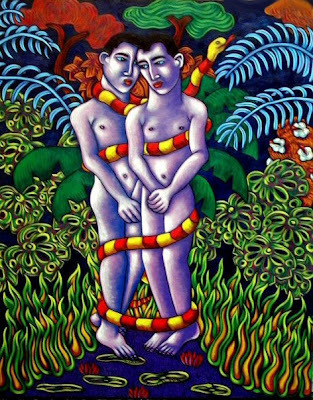
“Adam And Steve In Eden” by Tony De Carlo

Who says God didn’t create Adam and Steve? Artist Tony De Carlo affirms the goodness of same-sex love by painting the original gay couple.
He reimagines the Biblical creation story from a queer viewpoint. It’s visual theology in response to those who oppose LGBT rights with the foolish argument that “God made Adam and Eve, not Adam and Steve.”
De Carlo has done more than 20 paintings of Adam and Steve as the original gay couple. I am posting some of them today for the annual Queer Theology Synchroblog. The theme this year is “Queer Creation.” A synchroblog is when a group of people all write about the same topic on the same day and post it to their personal blogs. We are creating our own queer versions of the creation myth.
De Carlo is a native of Los Angeles, now living in Savannah, Georgia. Raised Catholic, he started painting religious subjects to counteract the church’s demonization of LGBT people. His paintings confront the hypocrisy of the church, which has a long history of homoerotic images but condemns homosexuality. His work is exhibited regularly in museums and galleries throughout the United States.
Watch the relationship between Adam and Steve unfold -- usually with the snake and forbidden fruit from the creation story in Genesis.
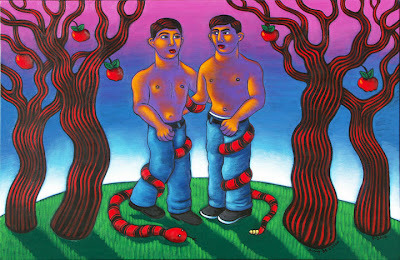
“Adam Y Steve” by Tony De Carlo
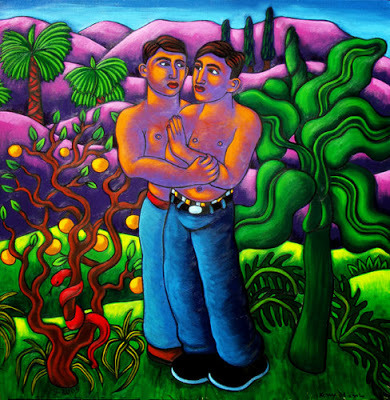
"Adam and Yves" by Tony de Carlo
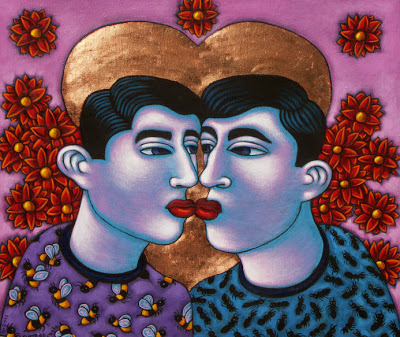
“Adam and Steve, Ants and Bees” by Tony de Carlo, 2013
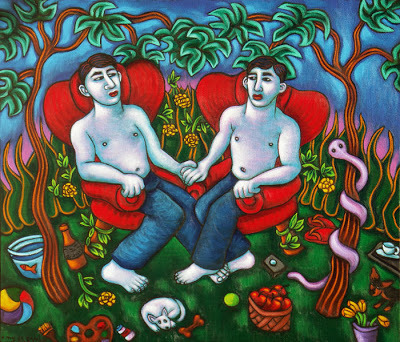
"Domestic Life of Adam and Steve" by Tony de Carlo
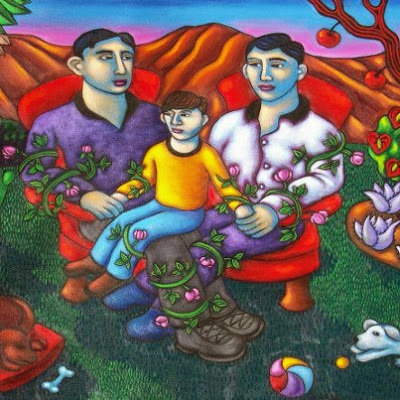
"Adam and Steve and Child" by Tony de Carlo, 2013

"Adam and Steve on the Farm" by Tony de Carlo
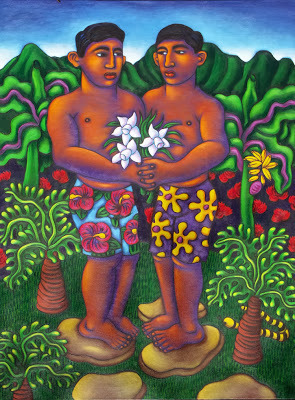
"Adam and Steve in Hawaii" by Tony de Carlo, 2013
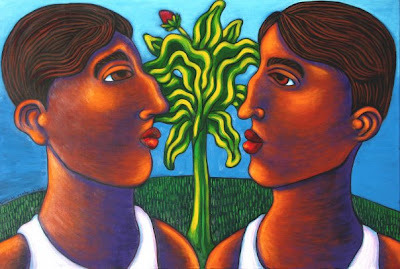
“Adam and Steve and the Banana Tree” by Tony De Carlo
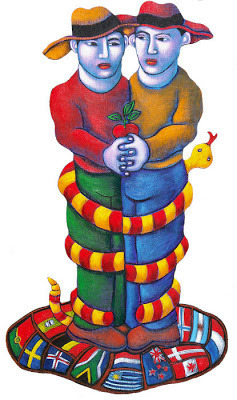
“Adam and Steve in 14 Countries” by Tony De Carlo shows them on an island made of flags from the countries that recognized marriage equality when he painted it earlier this year.
For more on Tony De Carlo and his art, see my previous post:
Gay saints, Adam & Steve, and marriage equality art affirms LGBT love: Tony De Carlo Interview (Jesus in Love)
___
Related links:
TonyDeCarlo.com
Tony De Carlo on Facebook
___
This post is part of the Artists series by Kittredge Cherry at the Jesus in Love Blog. The series profiles artists who use lesbian, gay, bisexual, transgender (LGBT) and queer spiritual and religious imagery.
Copyright © Kittredge Cherry. All rights reserved.
http://www.jesusinlove.blogspot.com/
Jesus in Love Blog on LGBT spirituality and the arts
Published on October 01, 2013 00:02
September 30, 2013
Rumi: Poet and Sufi mystic inspired by same-sex love
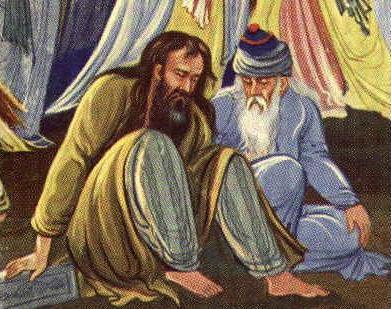 Rumi and Shams together in a detail from “Dervish Whirl” by Shahriar Shahriari (RumiOnFire.com)
Rumi and Shams together in a detail from “Dervish Whirl” by Shahriar Shahriari (RumiOnFire.com)Rumi is a 13th-century Persian poet and Sufi mystic whose love for another man inspired some of the world’s best poems and led to the creation of a new religious order, the whirling dervishes. His birthday is today (Sept. 30).
With sensuous beauty and deep spiritual insight, Rumi writes about the sacred presence in ordinary experiences. His poetry is widely admired around the world and he is one of the most popular poets in America. One of his often-quoted poems begins:
If anyone asks you
how the perfect satisfaction
of all our sexual wanting
will look, lift your face
and say,
Like this.*
The homoeroticism of Rumi is hidden in plain sight. It is well known that his poems were inspired by his love for another man, but the queer implications are seldom discussed. There is no proof that Rumi and his beloved Shams of Tabriz had a sexual relationship, but the intensity of their same-sex love is undeniable.
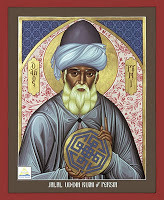
“Rumi of Persia”by Robert LentzTrinityStores.com
Rumi was born Sept. 30, 1207 in Afghanistan, which was then part of the Persian Empire. His father, a Muslim scholar and mystic, moved the family to Roman Anatolia (present-day Turkey) to escape Mongol invaders when Rumi was a child. Rumi lived most of his life in this region and used it as the basis of his chosen name, which means “Roman.” His full name is Jalal ad-Din Muhammad Balkhi-Rumi.
His father died when Rumi was 25 and he inherited a position as teacher at a madrassa (Islamic school). He continued studying Shariah (Islamic law), eventually issuing his own fatwas (legal opinions) and giving sermons in the local mosques. Rumi also practiced the basics of Sufi mysticism in a community of dervishes, who are Muslim ascetics similar to mendicant friars in Christianity.
On Nov. 15, 1244 Rumi met the man who would change his life: a wandering dervish named Shams of Tabriz (Shams-e-Tabrizi or Shams al-Din Muhammad). He came from the city of Tabriz in present-day Iranian Azerbaijan. It is said that Shams had traveled throughout the Middle East asking Allah to help him find a friend who could “endure” his companionship. A voice in a vision sent him to the place where Rumi lived.
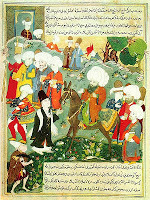
Meeting of Rumi and Shams
16th-17th century folio
(Wikimedia Commons)
Rumi, a respected scholar in his thirties, was riding a donkey home from work when an elderly stranger in ragged clothes approached. It was Shams. He grasped the reins and started a theological debate. Some say that Rumi was so overwhelmed that he fainted and fell off the donkey.
Rumi and Shams soon became inseparable. They spent months together, lost in a kind of ecstatic mystical communion known as “sobhet” -- conversing and gazing at each other until a deeper conversation occurred without words. They forgot about human needs and ignored Rumi’s students, who became jealous. When conflict arose in the community, Shams disappeared as unexpectedly as he had arrived.
Rumi’s loneliness at their separation led him to begin the activities for which he is still remembered. He poured out his soul in poetry and mystical whirling dances of the spirit.
Eventually Rumi found out that Shams had gone to Damascus. He wrote letters begging Shams to return. Legends tell of a dramatic reunion. The two sages fell at each other’s feet. In the past they were like a disciple and teacher, but now they loved each other as equals. One account says, “No one knew who was lover and who the beloved.” Both men were married to women, but they resumed their intense relationship with each other, merged in mystic communion. Jealousies arose again and some men began plotting to get rid of Shams.
One winter night, when he was with Rumi, Shams answered a knock at the back door. He disappeared and was never seen again. Many believe that he was murdered.
Rumi grieved deeply. He searched in vain for his friend and lost himself in whirling dances of mourning. One of his poems hints at the his emotions:
Dance, when you’re broken open.
Dance, if you’ve torn the bandage off.
Dance in the middle of the fighting.
Dance in your blood.
Dance, when you’re perfectly free.
Rumi danced, mourned and wrote poems until the pressure forged a new consciousness. “The wound is the place where the Light enters you,” he once wrote. His soul fused with his beloved. They became One: Rumi, Shams and God. He wrote:
Why should I seek? I am the same as he.
His essence speaks through me.
I have been looking for myself.
After this breakthrough, waves of profound poetry flowed out of Rumi. He attributed more and more of his writings to Shams. His literary classic is a vast collection of poems called “The Works of Shams of Tabriz.” The Turkish government refused to help with translation of the last volume, which was finally published in 2006 as The Forbidden Rumi: The Suppressed Poems of Rumi on Love, Heresy, and Intoxication
 . It was forbidden both because of its homoerotic content and because it promotes the “blasphemy” that one must go beyond religion in order to experience God.
. It was forbidden both because of its homoerotic content and because it promotes the “blasphemy” that one must go beyond religion in order to experience God.Rumi went on to live and love again, dedicating poems to other beloved men. His second great love was the goldsmith Saladin Zarkub. After the goldsmith’s death, Rumi’s scribe Husan Chelebi became Rumi’s beloved companion for the rest of his life. Rumi died at age 66 after an illness on Dec. 17, 1273. Soon his followers founded the Mevlevi Order, known as the whirling dervishes because of the dances they do in devotion to God.
___
Related links:
Rumi and Shams: A Love of Another Kind (Wild Reed)
Ramesh Bjonnes on Rumi and Shams as Gay Lovers (Wild Reed)
Rumi at lgbtq.com
Another Male's Love Inspired Persia's Mystic Muse (GayToday.com)
Love Poems of Rumi at Rumi.org
Rumi quotes at Goodreads.com
*“Like This” is quoted from The Essential Rumi
 , which has translations by Coleman Barks with John Moyne. For the whole poem, visit Rumi.org.
, which has translations by Coleman Barks with John Moyne. For the whole poem, visit Rumi.org.___
This post is part of the GLBT Saints series by Kittredge Cherry at the Jesus in Love Blog. Saints, martyrs, mystics, heroes, holy people, deities and religious figures of special interest to lesbian, gay, bisexual and transgender (LGBT) and queer people and our allies are covered on appropriate dates throughout the year.
Published on September 30, 2013 09:14
September 28, 2013
Good (Gay?) King Wenceslas
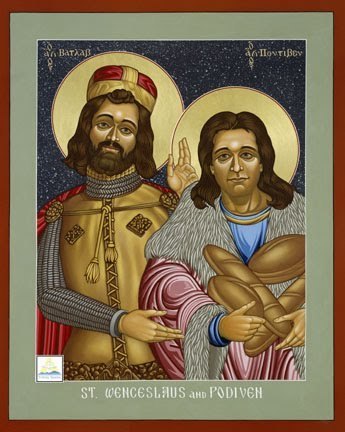
St. Wenceslaus and Podiven
By Lewis Williams, SFO. © www.trinitystores.com
There’s good reason to believe that Good King Wenceslas was gay. Yes, the king in the Christmas carol. His feast day is today (Sept. 28).
Saint Wenceslaus I (907–935) was duke of Bohemia (now the Czech Republic). The carol "Good King Wenceslas" is based on a legend about Wenceslaus and his loyal page Podiven. According to the story, it was a bitterly cold night when they went out to give alms to the poor on the Feast of St. Stephen, Dec. 26. Podiven could not walk any farther on his bare, frozen feet, so Wenceslas urged him to follow in his footsteps. His footprints in the snow stayed miraculously warm, allowing the pair to continue safely together.
Many details in the Christmas carol are pious fiction, but the king and his page are both grounded in historical truth. The following is based partly on research from Dennis O’Neill, author of “Passionate Holiness
 .”
.”The earliest accounts of Wenceslaus’ life mention his page -- but not the woman who supposedly gave birth to his son in more recent versions. An account written in the late 10th or early 11th century describes the young man who was a “worthy page” and “chamber valet” to Wenceslaus.
It says that Wenceslaus used to wake his page in the middle of the night to join him in doing charitable works. The page is described as “a youth from among his valets who, of all his servants, was the most trustworthy in secret matters. The saint himself truly loved him during his lifetime.”
Wenceslaus was murdered in a coup by his brother at the door of a church on Sept. 28 in the year 935. The records say that Podiven “was often overcome by grief, sorrowing for days on end.” The brother also had Podiven killed to stop him from spreading stories of the saintly Wenceslaus. Both Wenceslaus and his beloved Podiven are buried at St. Vitus Cathedral in Prague.
The icon above was painted by Colorado artist Lewis Williams of the Secular Franciscan Order (SFO). He studied with master iconographer Robert Lentz and has made social justice a theme of his icons. It is dedicated to the memory of Father Larry Craig, a Chicago priest known for service to the Latino community and prison ministry. Before his death in 2006, Father Craig used to stand outside the Cook County Jail at night, giving sandwiches and bus passes to surprised inmates who had just been released. He served as the model for Podiven’s face in this icon.
May these facts warm your heart whenever you hear or sing the Christmas carol “Good King Wenceslas.”
___
Related link:
San Venceslao I de Bohemia y Podiven: Venceslao, el buen rey (gay?) at Santos Queer
____
This post is part of the GLBT Saints series by Kittredge Cherry at the Jesus in Love Blog. Saints, martyrs, mystics, prophets, witnesses, heroes, holy people, humanitarians, deities and religious figures of special interest to lesbian, gay, bisexual and transgender (LGBT) and queer people and our allies are covered on appropriate dates throughout the year.
Copyright © Kittredge Cherry. All rights reserved.
http://www.jesusinlove.blogspot.com/
Jesus in Love Blog on LGBT spirituality and the arts
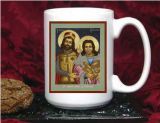
The Wenceslaus and Podiven icon and many others are available on cards, plaques, T-shirts, mugs, candles, mugs, and more at Trinity Stores

Published on September 28, 2013 09:55
September 22, 2013
Tyler Clementi: Gay teen driven to suicide by bullies
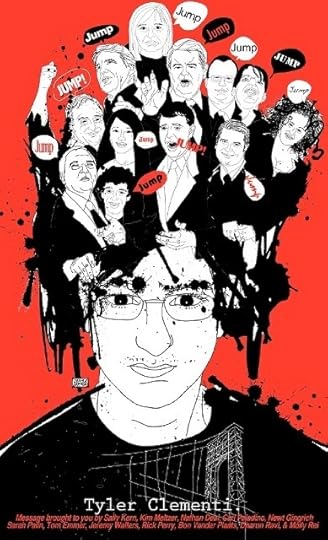 “Tyler Clementi, JUMP!” by Louisa Bertman
“Tyler Clementi, JUMP!” by Louisa BertmanTyler Clementi (1992-2010) brought international attention to bullying-related suicide of LGBT youth by jumping to his death on Sept. 22, 2010 (three years ago today).
Clementi’s highly publicized tragedy made him into a gay martyr whose untimely death put a public face on the problems of LGBT teenagers. His story sparked efforts to support LGBT youth, raise awareness of the harassment they face, and prevent suicide among queer young people. Another result is new legislation stiffening penalties for cyber harassment.
His parents once considered suing Rutgers over their son's death, but in February 2013 they announced that they were working with the university to form the Tyler Clementi Center at Rutgers. It sponsors conferences and academic research to help students make the transition to college. They also established the Tyler Clementi Foundation to promote acceptance of LGBT youth and more inclusive society.
Clementi was an 18-year-old freshman at Rutgers University in New Jersey when he was driven to suicide by his room mate's anti-gay cyber-bullying.
 A talented violinist, Clementi came out to his parents as gay before leaving home for college. Three days before the suicide, Clementi’s room mate used a webcam to secretly record Clementi kissing another man in their dorm room and streamed the video live over the Internet. In messages posted online before he took his own life, Clementi told how he complained to authorities about the cyber-bullying and asked for a new room assignment. Then he jumped off the George Washington Bridge. It took a week to find his body.
A talented violinist, Clementi came out to his parents as gay before leaving home for college. Three days before the suicide, Clementi’s room mate used a webcam to secretly record Clementi kissing another man in their dorm room and streamed the video live over the Internet. In messages posted online before he took his own life, Clementi told how he complained to authorities about the cyber-bullying and asked for a new room assignment. Then he jumped off the George Washington Bridge. It took a week to find his body.The room mate, Dharum Ravi, also 18 at the time, was convicted of on 15 counts, including invasion of privacy and bias intimidation, in connection with Clementi’s suicide. Ravi was sentenced to 30 days in jail, 3 years of probation, 300 hours of community service; fined $10,000, and ordered to undergo counseling on cyberbullying and alternate lifestyles. His accomplice, Molly Wei, avoided jail time by agreeing to testify against Ravi.
Anti-LGBT statements by public figures are also partly responsible for Clementi’s death. They created the hostile environment that drove Clementi to suicide. Artist Louisa Bertman emphasizes this point in her powerful ink illustration, “Tyler Clementi, JUMP!” She makes visible the hateful voices that may have been in Clementi’s mind. In her drawing, his head overflows with people urging him to jump. They are politicians as well as the actual students who bullied him. Their names are listed in a stark statement at the bottom of the drawing:
“Message brought to you by Sally Kern, Kim Meltzer, Nathan Deal, Carl Paladino, Newt Gingrich, Sarah Palin, Tom Emmer, Jeremy Walters, Rick Perry, Bob Vander Plaats, Dharun Ravi, and Molly Wei.”
Bertman, an artist based in Cambridge, Massachusetts, is known for her non-traditional portraits.
Clementi helped inspire the founding of the It Gets Better Project and Spirit Day. The It Get Better Project aims to stop suicide among LGBT teens with videos of adults assuring them that “it gets better.” Spirit Day, first observed on Oct. 20, 2010, is a day when people wear purple to show support for young LGBT victims of bullying.
Unfortunately Clementi’s experience is far from rare. Openly lesbian talk show host Ellen Degeneres spoke for many in a video message that put his suicide into context shortly after he died:
“I am devastated by the death of 18-year-old Tyler Clementi….Something must be done. This month alone, there has been a shocking number of news stories about teens who have been teased and bullied and then committed suicide; like 13-year-old Seth Walsh in Tehachapi, California. Asher Brown, 13, of Cypress, Texas and 15-year-old Billy Lucas in Greensberg, Indiana. This needs to be a wake-up call to everyone: teenage bullying and teasing is an epidemic in this country, and the death rate is climbing.”
Help is available right now from the Trevor Project, a 24-hour national help line for gay, lesbian, bisexual, transgender and questioning teens. Contact them at 866 4U TREVOR or their website: thetrevorproject.org.
___
Related links:
Tyler Clementi Foundation
Tyler Clementi Center at Rutgers
A Brother's Pledge: Standing Up For Love by James Clementi (Believe Out Loud)
It Gets Better Project video by Kittredge Cherry
Image credit: Tyler Clementi’s webcam photo of himself (Wikimedia Commons)
_________
This post is part of the GLBT Saints series by Kittredge Cherry at the Jesus in Love Blog. Saints, martyrs, mystics, heroes, holy people, deities and religious figures of special interest to lesbian, gay, bisexual and transgender (LGBT) and queer people and our allies are covered on appropriate dates throughout the year.
Copyright © Kittredge Cherry. All rights reserved.
http://www.jesusinlove.blogspot.com/
Jesus in Love Blog on LGBT spirituality and the arts
Published on September 22, 2013 10:00
September 21, 2013
Henri Nouwen: Priest and author who struggled with his homosexuality
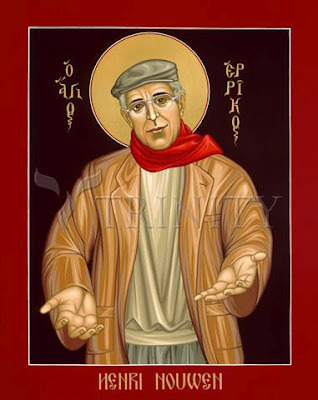 “Henri Nouwen” by Br. Robert Lentz, trinitystores.com
“Henri Nouwen” by Br. Robert Lentz, trinitystores.comHenri J. M. Nouwen was a Catholic priest and bestselling author who wrestled with his own homosexuality. He died 16 years ago today on Sept. 21, 1996.
Nouwen (1932-1996) remains one of the most popular and influential modern spiritual writers. He wrote more than 40 books, including The Wounded Healer
 , The Return of the Prodigal Son
, The Return of the Prodigal Son , and The Inner Voice of Love
, and The Inner Voice of Love .
.Known as a “gay celibate, he probably would have had mixed feelings about being included in this series on LGBT Saints. Nouwen never directly discussed his gay sexual orientation in his published writings, but he confided his conflict over it in private journals and conversations. These are documented in his outstanding and honest 2002 biography Wounded Prophet
 by Michael Ford. Despite his loneliness and same-sex attractions, there is no evidence that Nouwen ever broke his vow of celibacy.
by Michael Ford. Despite his loneliness and same-sex attractions, there is no evidence that Nouwen ever broke his vow of celibacy. His personal struggle with his sexual orientation may have added depth to his writing. “The greatest trap in our life is not success, popularity or power, but self-rejection,” he said.
Although Nouwen is not an officially recognized saint, his “spirituality of the heart” has touched millions of readers. Nouwen’s books have sold more than 2 million copies in over 22 languages. He emphasized relationships and social justice with core values of solitude, community and compassion.
Nouwen was born in Holland on Jan. 24, 1932. He was ordained as a Roman Catholic priest in 1957 and went on to study psychology. He taught at several theological institutes in his homeland and in the United States, including the divinity schools at Harvard and Yale.
In 1985 he began service in Toronto, Canada, as the priest at the L’Arche Daybreak Community, where people with developmental disabilities live with assistants. It became Nouwen’s home until his sudden death in 1996 at age 64. He died from a heart attack while traveling to Russia to do a documentary.
The video below shows Nouwen speaking on "Being the Beloved" at the Crystal Cathedral in California in 1992. The newest book about him is the 2012 biography “Genius Born of Anguish: The Life and Legacy of Henri Nouwen” by Michael Higgins, Nouwen’s official biographer.
The icon of Nouwen at the top of this post was painted by Brother Robert Lentz, a Franciscan friar known for his innovative and LGBT-positive icons. During his lifetime Nouwen commissioned Lentz to make an icon for him that symbolized the act of offering his own sexuality and affection to Christ.
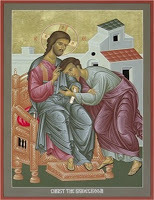
Christ the Bridegroom
by Robert Lentz
trinitystores.com
Research and reflection led Lentz to paint “Christ the Bridegroom” (left) for him in 1983. It shows Christ being embraced by his beloved disciple, based on an icon from medieval Crete. “Henri used it to come to grips with his own homosexuality,” Lentz explained in my book “Art That Dares,” which includes this icon and the story behind it. “I was told he carried it with him everywhere and it was one of the most precious things in his life.”
Lentz’s icon / portrait the top of this post shows Nouwen in an open-handed pose. It calls to mind a prayer written by Nouwen in The Only Necessary Thing: Living a Prayerful Life
 :
:Dear God,
I am so afraid to open my clenched fists!
Who will I be when I have nothing left to hold on to?
Who will I be when I stand before you with empty hands?
Please help me to gradually open my hands
and to discover that I am not what I own,
but what you want to give me.
Nouwen gave the gift of his spiritual vision to generations of readers. He encouraged each individual to find their own mission in life with words such as these from "The Wounded Healer":
“When the imitation of Christ does not mean to live a life like Christ, but to live your life as authentically as Christ lived his, then there are many ways and forms in which a man can be a Christian.”
___
Related links:
Henri Nouwen Society
Chris Glaser on Henri Nouwen’s sexuality (Huffington Post)
Henri Nouwen, on Andrew Sullivan and the “Blessing” of Homosexuality (Queering the Church)
___
 Icons of Henri Nouwen, Christ the Bridegroom and many others are available on cards, plaques, T-shirts, mugs, candles, mugs, and more at TrinityStores.com
Icons of Henri Nouwen, Christ the Bridegroom and many others are available on cards, plaques, T-shirts, mugs, candles, mugs, and more at TrinityStores.com
To watch the rest of the sermon, visit the following YouTube page with links to all 8 parts of Nouwen’s sermon on “Being the Beloved”:
http://www.youtube.com/user/belovedson12
____
This post is part of the GLBT Saints series by Kittredge Cherry at the Jesus in Love Blog. Saints, martyrs, mystics, prophets, witnesses, heroes, holy people, deities and religious figures of special interest to lesbian, gay, bisexual and transgender (LGBT) and queer people and our allies are covered on appropriate dates throughout the year.
Copyright © Kittredge Cherry. All rights reserved.
http://www.jesusinlove.blogspot.com/
Jesus in Love Blog on LGBT spirituality and the arts
Published on September 21, 2013 09:48
September 17, 2013
Hildegard of Bingen and Richardis: Medieval mystic and the woman she loved
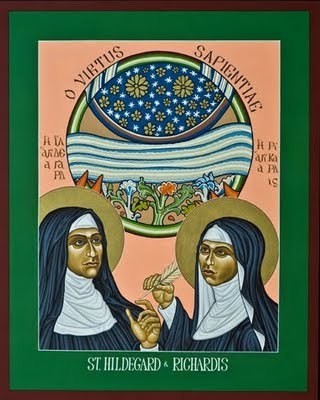
“St. Hildegard of Bingen and Her Assistant Richardis” by Lewis Williams, TrinityStores.com
Hildegard of Bingen was a medieval German nun, mystic, poet, artist, composer, healer and scientist. She founded several monasteries, fought for women in the church and wrote with passion about the Virgin Mary. Some say she was a lesbian because of her strong emotional attachment to women, especially her personal assistant Richardis von Stade. Hildegard was declared a doctor of the church by Pope Benedict XVI in 2013. Her feast day is Sept. 17 (today).
The title “Doctor of the Church” is a rare honor, bestowed upon only a few saints whose writings have universal value to the church. Their “eminent learning” and “great sanctity” must be affirmed by the Pope. Currently the Roman Catholic Church has only 33 doctors, including three women.
The friendship -- or love story -- between Hildegard and Richardis is included in a 2009 film from German feminist director Margarethe von Trotta called Vision: From the Life of Hildegard von Bingen
 . Von Trotta is one of the world’s most important feminist filmmakers and a leader of independent German cinema. Von Trotta allows Hildegard to speak for herself by using a script based on Hildegard’s own writings and a soundtrack filled with Hildegard’s music. Watch a trailer at the end of this post.
. Von Trotta is one of the world’s most important feminist filmmakers and a leader of independent German cinema. Von Trotta allows Hildegard to speak for herself by using a script based on Hildegard’s own writings and a soundtrack filled with Hildegard’s music. Watch a trailer at the end of this post.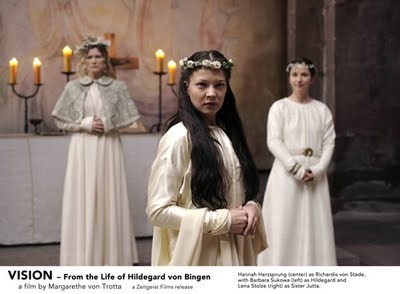
Richardis von Stade (center, played by Hannah Herzsprung) and Hildegard (left, Barbara Sukowa) in the biopic “Vision” (from zeitgeistfilms.com)
Hildegard also inspired a play by lesbian feminist playwright Carolyn Gage. In the play “Artemisia and Hildegard,” Gage has two of history’s great women artists debate their contrasting survival strategies: Gentileschi battled to achieve in the male-dominated art world while Hildegard created women-only community to support her art by founding a nunnery.
Hildegard of Bingen (1098-1179), the tenth child of a noble family, was offered to the church as a “tithe” when she was very young. She was raised from the age of 8 in the hermitage that later became her Benedictine abbey. She founded two other convents where women performed her music and developed their artistic, intellectual and spiritual gifts. She spent almost all of her life in the company of women.
She had visions throughout her life, starting at age 3 when she says that she first saw “the Shade of the Living Light.” She hesitated to tell others about her visions, sharing them only with her teacher Jutta.
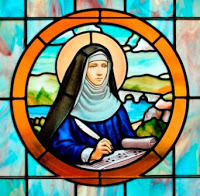
St. Hildegard of Bingen
by Plamen Petrov
St. Martha Church
Morton Grove, IL
When she was 42, Hildegard had a vision in which God instructed her to record her spiritual experiences. Still hesitant, she became physically ill before she was persuaded to begin her first visionary work, the Scivias (Know the Ways of God).
Hildegard was nursed in her illness and encouraged in her writing by Richardis von Stade, a younger woman who was her personal assistant, soul mate and special favorite. Whether or not they were physically intimate, Hildegard’s actions suggest that she was a lesbian in the sense that her primary love interest was in women.
In 1151, Hildegard completed the Scivias and trouble arose between her and her beloved Richardis. An archbishop, the brother of Richardis, arranged for his sister to become abbess of a distant convent. Hildegard urged Richardis to stay, and even asked the Pope to stop the move. But Richardis left anyway, over Hildegard’s objections.
Hildegard wrote intense letters begging Richardis to return: “I loved the nobility of your conduct, your wisdom and your chastity, your soul and the whole of your life, so much that many said: What are you doing?”
Richardis died suddenly in October 1151, when she was only about 28 years old. On her deathbed, she tearfully expressed her longing for Hildegard and her intention to return.
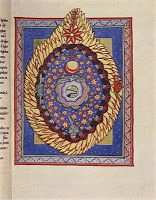
“The Universe”
by Hildegard of Bingen
Wikimedia Commons
Hildegard’s grief apparently fueled further artistic creation. Many believe that Richardis was the inspiration for Ordo Virtutum (“Play of Virtues”}, a musical morality play about a soul who is tempted away by the devil and then repents. According to Wikipedia, “It is the earliest morality play by more than a century, and the only Medieval musical drama to survive with an attribution for both the text and the music.”
In an era when few women wrote, Hildegard went on to create two more major visionary works, a collection of songs, and several scientific treatises. She was especially interested in women’s health. Her medical writings even include what may be the first description of a female orgasm.
As a church leader, Hildegard had to support its policy against homosexual behavior. But she often wrote about the divine feminine and the dignity of women, presenting sexuality in a generally positive way. She wrote, “Creation looks on its Creator like the beloved looks on the lover.” Many readers today delight in her erotic descriptions of marriage as a metaphor for the union of a soul with God. Hildegard writes:
The soul is kissed by God in its innermost regions.
With interior yearning, grace and blessing are bestowed.
It is a yearning to take on God's gentle yoke,
It is a yearning to give one's self to God's Way.
In the Symphonia, a collection of liturgical songs to Mary, Hildegard writes with ecstatic passion of her love and devotion to the Virgin Mary. She extols Mary as “greenest twig” and sings the praises of her womb, which “illuminated all creatures.”
Her songs to Mary are available for listening in the following video and on the Sequentia recording, “Hildegard von Bingen: Canticles of Ecstasy
 .” Her music is still just as beautiful today.
.” Her music is still just as beautiful today. Hildegard died on Sept. 17, 1179 at age 81. The sisters at her convent said they saw two streams of colorful lights cross in the sky above her room. She became a saint by popular acclamation.
The icon of Hildegard and Richardis at the top of this post was painted by Colorado artist Lewis Williams of the Secular Franciscan Order (SFO). He studied with master iconographer Robert Lentz and has made social justice a theme of his icons.
LGBT-affirming creation theologian Matthew Fox has written two books on the life and work of Hildegard. The newest is Hildegard of Bingen: A Saint for Our Times: Unleashing Her Power in the 21st Century, which presents her as an "eco-warrior" who meets such luminaries as Albert Einstein, Howard Thurman, Dorothee Soelle and Clarissa Pinkola Estes. Fox also wrote Illuminations of Hildegard of Bingen
 .
.___
Related links:
Pope sets date to declare two new church doctors (Catholic News Agency)
Ritual to Honor Hildegard of Bingen by Diann L. Neu (WATER)
Hildegarda de Bingen y Richardis: Una mística que amaba a otra mujer (Santos Queer)
_______
This post is part of the GLBT Saints series at the Jesus in Love Blog. Saints and holy people of special interest to gay, lesbian, bisexual and transgender (GLBT) people and our allies are covered on appropriate dates throughout the year.
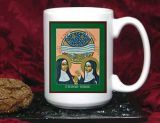
The Hildegard and Richardis icon is available on cards, plaques, T-shirts, mugs, candles, mugs, and more at TrinityStores.com

Published on September 17, 2013 09:17
September 12, 2013
Gay artist paints "Intimacy with Christ": Richard Stott reflects on sensual spirituality
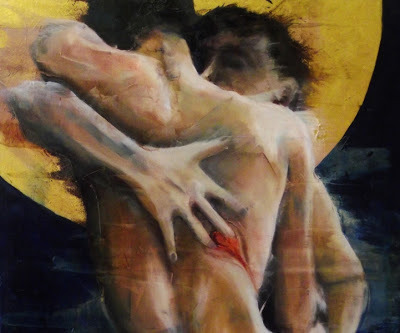 Detail from “Intimacy with Christ 3” by Richard Stott (for full image click here)
Detail from “Intimacy with Christ 3” by Richard Stott (for full image click here)A gay man’s intimacy with Christ is expressed in new art and writing by Richard Stott, a Methodist minister and art therapist in Sheffield, England.
Three large paintings that unite sexuality and spirituality emerged from Stott’s prayer life and meditations on the medieval Christian mystics, especially the poem “The Dark Night of the Soul” by Saint John of the Cross.
“They reach towards the experience of a deep and intimate engagement with Christ. They are not about sex per se but there is an erotic aspect to them. Sexual desire, our desire for the other, to be close to them and entwined with them is, to my mind, an echo of our desire for God and God’s desire for us. In the Christian tradition that is expressed in God coming close to us in the body of Christ,” Stott writes.
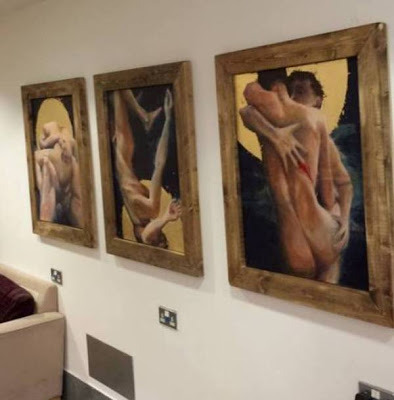 “Intimacy with Christ” triptych by Richard Stott on display
“Intimacy with Christ” triptych by Richard Stott on displayThe triptych debuted in June at Hidden Perspectives, an arts festival for “bringing the Bible out of the closet” in Sheffield. Stott also posted reflections on each of the paintings at his blog, I Ask for Wonder: Exploring Art, Spirituality and Sacred Spaces in Sheffield and Beyond…. He agreed to share his work here at the Jesus in Love blog.
His first reflection is reprinted below in full, followed by summaries of his other two essays. Images have been cropped for a general audience. The paintings are oil and gold leaf on canvas, measuring approximately 24 by 31 inches.
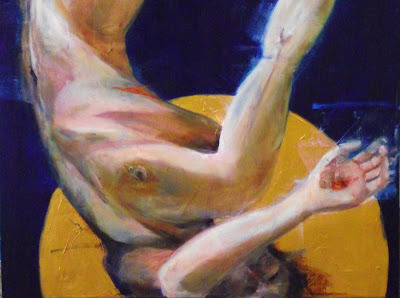 Detail from “Intimacy with Christ 2” by Richard Stott (for full image click here)
Detail from “Intimacy with Christ 2” by Richard Stott (for full image click here)“He touches my neck and all my senses are suspended”By Richard Stott
Recently I have been stunned by a famous poem by St John of the Cross from his work ‘The Dark Night of the Soul’. In the poem he writes of a spiritual encounter that is deep, beyond words and expresses it in the sensual language of physical intimacy:
Wind blew down from the tower,
Parting the locks of his hair.
With his gentle hand
He wounded my neck
And all my senses were suspended.
I lost myself. Forgot myself.
I lay my face against the Beloved’s face.
Everything fell away and I left myself behind,
Abandoning my cares
Among the lilies, forgotten.
You can read a translation of the whole poem here.
When I read these words echoing down through the years from this 16th Century Spanish mystic I was cut to the heart as they resonate so strongly with my experience of Christ.
I need to take care here as I don’t want to universalise my experience, to imply that everyone should have the same kind of encounter. For some people the idea of relating to Christ at all is unhelpful. Furthermore, many people who do seek to engage with him may very well not do so in the same way as me and nor should they because we each need to work out our own way of engaging with the world and the transcendent. So take my reflections as what they are: the particular experience of a gay Christian using contemplative prayer to engage with Jesus.
One of the key ideas in Christianity, that the church often doesn’t realise the full implications of, is that Jesus had a body. This faith isn’t about some vague spiritual thing wafting around but is about material things and is expressed in a real human body (And whether the stories of Jesus are historically factual or not is irrelevant to me on this because the truth expressed in the myth* of the gospel stories is that the Christian faith is about a real body).
If Jesus had a body then he had blood, mucus, hormones and all kinds of dirty, messy and beautiful things that make us human. He had drives and desires and was a sexual being. When I first thought of this it seemed scandalous to me. I was in a little Catholic Church on the pilgrim road to Santiago de Compostela in Spain. I looked up at the sculpture of Jesus on the cross, his beautiful body twisted and taut in pain or ecstasy and I felt desire for him, a desire for the body of Christ. I wanted to touch his body and be touched by him, to possess him and be possessed by him and in that mutual possession be transformed. I had unwittingly stumbled on and tentatively touched that deep and sensuous spiritual experience expressed by St John of the Cross.
Over the last few months I have been working on some very personal paintings that explore this experience of Jesus and I will offer reflections on each of them over the next few weeks. I share them with some trepidation as it feels like I’m exposing something of my soul but it seems to me that the artists journey is a continual breaking oneself open as we seek to express truths that lie beyond the reach of words.
The golden numinous in each of the paintings is reminiscent of orthodox Christian icons. Icons are not used as idols or objects of worship but are windows to look through so that we may glimpse the divine. I hope these paintings may, in a small way, be windows that open up our horizons and the possibilities of understanding ourselves and of the beautiful transcendent reality that I find embodied in the person of Jesus.
*myth is not a pejorative term but means a story that expresses a truth – often universal truths about human nature and experience
_____________
That concludes Stott’s first essay. Use the following links for his reflections on the other two paintings in his “Intimacy with Christ” triptych.
“You are in me and I am in you by Richard Stott explores how the risen Christ invited his friend Thomas to confirm the resurrection by touching his wounds. In another part of the Bible Christ promised “an intimate and passionate intertwining.” This embodied faith is also reflected in a prayer by Symeon the New Theologian.
“Lover and beloved moved in unison” by Richard Stott looks at sexual desire as “one of the tributaries of the soul that leads to the wider desire for God.” This yearning is expressed in the Eucharist, the poetry of John of the Cross, and the ecstasy of Teresa of Avila.
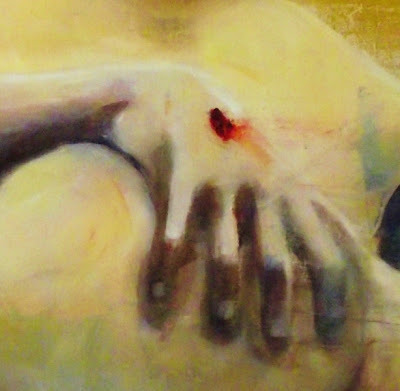 Detail from “Intimacy with Christ 1” by Richard Stott (for full image click here)
Detail from “Intimacy with Christ 1” by Richard Stott (for full image click here)___
Related links at Jesus in Love:
An Erotic Encounter with the Divine by Eric Hays-Strom
Erotic Christ teacher speaks: We are the erotic body of Christ (Hunter Flournoy)
Erotic Christ / Rethinking Sin and Grace for LGBT People (Patrick Cheng)
____
This post is part of the Queer Christ series by Kittredge Cherry at the Jesus in Love Blog. The series gathers together visions of the queer Christ as presented by artists, writers, theologians and others. More queer Christ images are compiled in my book Art That Dares: Gay Jesus, Woman Christ, and More
 .
.Copyright © Kittredge Cherry. All rights reserved.
http://www.jesusinlove.blogspot.com/
Jesus in Love Blog on LGBT spirituality and the arts
Published on September 12, 2013 10:29
September 11, 2013
Mychal Judge, gay saint of 9/11 and chaplain to New York firefighters
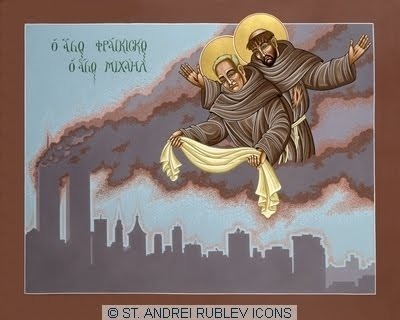
“Holy Passion Bearer Mychal Judge and St. Francis of Assisi” by Father William Hart McNichols
Father Mychal Judge, chaplain to New York firefighters and unofficial “gay saint,” died helping others in the terrorist attack on the World Trade Center 12 years ago today on Sept. 11, 2001.
Now as people pray and petition for peace in Syria, it is appropriate to remember the priest who was killed by flying debris while praying and administering sacraments at the World Trade Center. Father Mychal (1933-2001) was the first recorded victim of 9/11.
He responded quickly when extremists flew hijacked planes into the twin towers. He rushed with firefighters into the north tower right after the first plane hit. Refusing to be evacuated, he prayed and gave sacraments as wreckage crashed outside. He saw dozens of bodies hit the plaza outside as people jumped to their deaths. His final prayer, repeated over and over, was “Jesus, please end this right now! God, please end this!”
While he was praying, Father Mychal was struck and killed in a storm of flying steel and concrete that exploded when the south tower collapsed. Father Mychal was designated as Victim 0001 because his was the first body recovered at the scene. More than 2,500 people from many nationalities and walks of life were killed. Thousands more escaped the buildings safely.
After Father Mychal’s death, some of his friends revealed that he considered himself a gay man. He had a homosexual orientation, but by all accounts he remained faithful to his vow of celibacy as a Roman Catholic priest of the Franciscan order.
The charismatic, elderly priest was a long-term member of Dignity, the oldest and largest national lay movement of LGBT Catholics and their allies. Father Mychal voiced disagreement with the Vatican’s condemnation of homosexuality, and found ways to welcome Dignity’s AIDS ministry despite a ban by church leaders. He defied a church boycott of the first gay-inclusive St. Patrick’s Day parade in Queens, showing up in his habit and granting news media interviews.
Many people, both inside and outside the LGBT community, call Father Mychal a saint. He has not been canonized yet by his own Roman Catholic Church, but some feel that he has already become a saint by popular acclamation, and the Orthodox-Catholic Church of America did declare officially declare him a saint.
The icon at the top of this post was painted by Father William Hart McNichols. He shows Father Mychal with St. Francis of Assisi as the World Trade Center burns behind them. The text that accompanies the icon describes Father Mychal as a Passion Bearer who “takes on the on-coming violence rather than returning it… choosing solidarity with the unprotected.”
Another icon of Father Mychal was done by Brother Robert Lentz, is a Franciscan friar known for his innovative and LGBT-positive icons. He is stationed at Holy Name College in Silver Spring, Maryland.
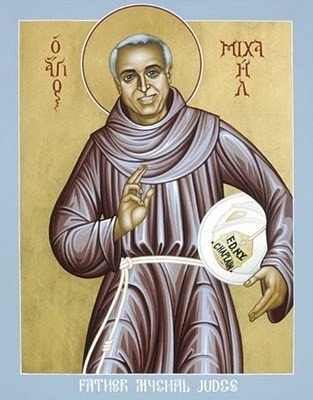
“Father Mychal Judge” by Brother Robert Lentz, trinitystores.com
McNichols is a Roman Catholic priest based in New Mexico. He has a deep connection to New York City because he worked at an AIDS hospice there in the 1980s. Both McNichols and Lentz have faced controversy for painting gay-affirming icons. They are two of the 11 artists whose life and work are featured in “Art That Dares: Gay Jesus, Woman Christ, and More ” by Kittredge Cherry.
Stories from the life of Father Mychal are presented in the book, “Mychal's Prayer: Praying with Father Mychal Judge
 ” by Salvatore Sapienza, a former monk who worked with Father Mychal to build St. Francis AIDS Ministry in New York City. The book mixes prayers with stories from the chaplain’s life. It begins with Father Mychal’s own words, a text that has come to be known simply as “Mychal’s Prayer”:
” by Salvatore Sapienza, a former monk who worked with Father Mychal to build St. Francis AIDS Ministry in New York City. The book mixes prayers with stories from the chaplain’s life. It begins with Father Mychal’s own words, a text that has come to be known simply as “Mychal’s Prayer”:
Lord, take me where You want me to go;
Let me meet who You want me to meet;
Tell me what You want me to say; and
Keep me out of your way.
For an excerpt from the book, see my previous post 10 years later: Mychal Judge, gay saint of 9/11. Sapienza is also the author of Seventy Times Seven: A Novel
 , a novel about a young Catholic brother torn between his sexuality and his spirituality as an out and proud gay man.
, a novel about a young Catholic brother torn between his sexuality and his spirituality as an out and proud gay man.The film Saint of 9/11 - The True Story of Father Mychal Judge
 is a complete and uplifting documentary on Father Mychal’s life, including his gay orientation and his support for LGBT rights. Its producers include Brendan Fay, who directed “Taking a Chance on God,” a biopic about gay priest John McNeill.
is a complete and uplifting documentary on Father Mychal’s life, including his gay orientation and his support for LGBT rights. Its producers include Brendan Fay, who directed “Taking a Chance on God,” a biopic about gay priest John McNeill.Another gay man who died heroically helping others in the Sept. 11 attack was rugby champion Mark Bingham, who lost his life while fighting hijackers on Flight 93. His story is told in my previous post at this link.
On the anniversary of the 9/11 attacks, may these images and stories inspire people with renewed dedication to peace and service to humanity. An excellent interfaith selection of prayers for peace is available at WorldPrayers.org. It includes prayers by Father Mychal as well as Sister Joan Chittister, Dr. Maya Angelou, Rabbi Harold Kushner, Dr. Clarissa Pinkola Estés, Dr. Jane Goodall, Rumi, Lao-Tse, Mahatma Gandhi, Muhammad, Jesus and many more.
___
Related link:
Saint Mychal Judge Blog
____
Mychal Judge is the first recorded victim of 9/11 -- and also the first saint in the GLBT Saints series by Kittredge Cherry at the Jesus in Love Blog. The series began on Sept. 11, 2009, and has grown to include many saints, martyrs, mystics, prophets, witnesses, heroes, holy people, humanitarians, deities and religious figures of special interest to lesbian, gay, bisexual and transgender (LGBT) and queer people and our allies. They are covered on appropriate dates throughout the year.
Copyright © Kittredge Cherry. All rights reserved.
http://www.jesusinlove.blogspot.com/
Jesus in Love Blog on LGBT spirituality and the arts
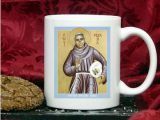
The Mychal Judge icon is available on cards, plaques, T-shirts, mugs, candles, mugs, and more at TrinityStores.com

Published on September 11, 2013 08:26
Q Spirit
Q Spirit promotes LGBTQ spirituality, with an emphasis on books, history, saints and the arts.
- Kittredge Cherry's profile
- 9 followers



